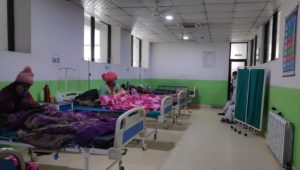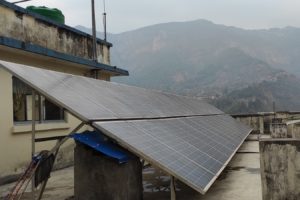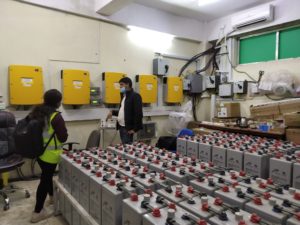A team of Griffith global health experts is facilitating a national project to build climate-resilient hospitals in the shadow of the world’s highest mountain.
Researchers from Griffith’s Centre for Environmental and Population Health (CEPH) have partnered with Health Environment and Climate Action Foundation 360 (HECAF360) to implement the World Health Organization Guide for Climate Resilient and Environmentally Sustainable Health Care Facilities in three ecological regions across Nepal.

A Nepalese hospital involved in the climate-resilience plan.
The project is funded by the World Health Organization Country Office for Nepal and has support from the Government of Nepal Department of Health Services.
Griffith PhD candidate Connie Gan said CEPH’s facilitation of the pilot project was crucial to improving healthcare in the South Asian country well-known for climate-related disasters, like floods, infectious disease outbreaks, bush fire and heatwaves.
“Climate-resilient and environmentally sustainable health care facilities refer to those able to anticipate, respond to, cope with, recover from and adapt to reduce health impacts, climate-related shocks and stresses,” Ms Gan said.

PhD candidate Connie Gan.
“On a daily basis, they work to reduce environmental pollution and seize opportunities to restore and improve it.
“This allows them to deliver continuous and quality health care services to the community they serve.”
The project covers a climate vulnerability assessment and disaster preparedness at proposed sites in three ecological regions, being the Terai region (Gaur Hospital), the hill region (Dhaulagiri Hospital) and the mountain region (Jumla Hospital).
“This is the first national pilot project since the WHO guide was published in October 2020,” HECAF360 Executive Director Mahesh Nakarmi said.

Radiators can be used to reduce the risk of infection.
The organisation, based in Kathmandu, is a pioneer in environmentally safe health care waste management systems and non-burn technology in healthcare settings.
“Nepal is the perfect country to apply the assessment methodology because of its unique geographical terrain,” Mr Nakarmi said.
“There is no other country in the world that has the same range in terms of ecosystems.
“Griffith’s CEPH is the ideal partner in this effort because of its expertise in health and climate change.”

The effectiveness of solar panels is being analysed.
The climate vulnerability assessment looks at whether an area is at higher risk of flood, landslide, or fire, the density of population, access to transportation in rural areas, climate-sensitive disease surveillance, existing climate adaptation activities and climate services.
This includes analysis of the effectiveness of radiators to keep patients warm and reduce the risk of hospital-acquired infections, a recycling system to reduce emissions and generate income, relocation of generators to flood-free zones, and capability of solar panels as a renewable and reliable source of energy, which is particularly important in the instance of a disaster.
Ms Gan said once the assessment was complete, concrete measures aimed at reducing emissions from health facilities and helping them to adapt to the impacts of climate change would be implemented.

The solar battery backup and control room at a hospital.
“We hope to document the new advances in knowledge (and) experiences, and lessons learned from the pilot hospitals could serve as a model to improve implementations in Nepalese hospitals and beyond,” Ms Gan said.
Director Professor Cordia Chu said the project aligned perfectly with CEPH’s core values.
“At CEPH, we address pressing concerns for population health, environmental sustainability and economic opportunity by working in partnership with international communities through research, consultancy, capacity building and by nurturing leaders,” Professor Chu said.
“This project encompasses all those aims and supports our vision to strengthen environmental and population health at a time when it is more under threat than ever.”



